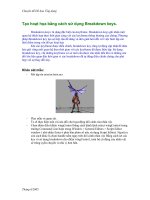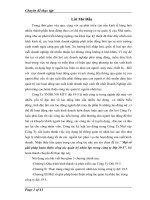IF FMT06 AU09 tutorial 5 keys bcdfdfhgdfhfdh
Bạn đang xem bản rút gọn của tài liệu. Xem và tải ngay bản đầy đủ của tài liệu tại đây (83.3 KB, 3 trang )
International Finance
Tutorial 5
TUTORIAL 5
Exchange Rate Systems and Government Intervention
TRUE-FALSE QUIZ
1. A currency board is a system for maintaining the value of the local currency with respect to
some other specified currency. To do this, the currency board must have credibility in its promise
to maintain the exchange rate.
a. True
Correct. Without credibility, actions taken to maintain the currency at the specified
level would have little effect.
2. Three members of the European Union initially decided not to participate in the single
European currency (euro). These countries are the United Kingdom, Denmark, and Sweden.
a. True
Correct. These are the three countries that initially chose not to participate.
3. The European Central Bank is based in Frankfurt and is responsible for setting monetary
policy for all participating European countries. Its objective is to control inflation in the
participating countries and to stabilize the value of the euro with respect to other major
currencies.
a. True
Correct.
4. One method of direct intervention by the U.S. Federal Reserve System in currency markets is
to sell dollars and buy foreign currencies to make the U.S. dollar depreciate.
a. True
Correct. "Flooding the market with dollars" is direct intervention by the Fed to
place downward pressure on the dollar by increasing its supply and increasing the
demand for another currency. Indirect intervention occurs when the Fed affects the
dollar's value indirectly by influencing the factors that determine it.
5. Dollarization represents the replacement of a foreign currency with U.S. dollars. This process
is a little less drastic than a currency board.
a. False
Correct. While dollarization is the replacement of a foreign currency with U.S.
dollars, it is a step beyond a currency board, because it forces the local currency to
be the pegged to the U.S. dollar.
MULTIPLE CHOICE QUIZ
1. Some countries use a _________ exchange rate arrangement, in which their home currency's
value is pegged to a foreign currency or to some unit of account.
a. fixed
Incorrect. In a fixed exchange rate system, exchange rates are either held constant
or allowed to fluctuate only within very narrow boundaries. If an exchange rate
begins to move too much, governments can intervene to maintain it within the
boundaries. In some situations, a government would devalue or reduce the value of
its currency against other currencies.
1
International Finance
Tutorial 5
b. freely floating
Incorrect. In a freely floating exchange rate system, exchange rate values would be
determined by market forces without intervention by various governments.
c. managed float
Incorrect. A managed float resembles the freely floating system in that exchange
rates are allowed to fluctuate on a daily basis and official boundaries do not exist.
Yet, it is similar to the fixed system in that governments can and sometimes do
intervene to prevent their currencies from moving too much in a certain direction.
d. pegged
Correct. Under a pegged system, while the home currency's value is fixed in terms
of the foreign currency (or unit of account) to which it is pegged, it moves in line
with that currency against other currencies.
e. none of the above
Incorrect. Answer d is correct.
2. Which of the following strategies would result in successful sterilized intervention by the Fed
if it wanted to make the U.S. dollar depreciate in value?
a. sell dollars in the currency markets, buy government treasury bonds
Incorrect. Both of these actions would increase the money supply, making the
intervention unsterilized.
b. sell dollars in the currency markets, sell government treasury bonds
Correct. This would increase the supply of dollars in the currency market (causing
depreciation) and the sale of government securities would leave the money supply
unchanged.
c. buy dollars in the currency markets, buy government treasury bonds
Incorrect. This would decrease the supply of dollars on the currency market
(causing appreciation) and the purchase of government securities would increase the
money supply.
d. buy dollars in the currency markets, sell government treasury bonds
Incorrect. Both of these actions would decrease the money supply, making the
actions unsterilized and making the dollar appreciate.
3. Assume the Fed wants to boost exports for the United States. Which of the following
strategies would help boost exports?
a. raise interest rates
Incorrect. This would make the dollar appreciate. An appreciation of the currency
should reduce exports.
b. increase the money supply by selling government bonds
Incorrect. Although an increase in the money supply would result in dollar
depreciation, selling government bonds would decrease the money supply.
c. lower interest rates
Correct. Lower interest rates would make the dollar depreciate. A depreciation of
the currency should help boost exports.
d. decrease the money supply by selling government bonds
Incorrect. This would make the dollar appreciate. An appreciation of the currency
should reduce exports.
e. none of the above
Incorrect. Answer c is the correct answer.
2
International Finance
Tutorial 5
4. Assume the Fed wants to decrease inflation in the United States. Which of the following
strategies would help reduce inflation?
a. raise interest rates
Correct. A strong (appreciating currency) will dampen inflation. Increasing interest
rates would make the dollar appreciate.
b. increase the money supply by buying government bonds
Incorrect. Increasing the money supply would weaken the currency and cause an
increase in inflation.
c. lower interest rates
Incorrect. This would make the dollar depreciate and potentially increase inflation.
d. decrease the money supply by buying government bonds
Incorrect. Although a decrease in the money supply would result in currency
appreciation, buying government bonds increases the money supply.
DISCUSSION QUESTION
1. What do the European Union nations hope to gain from the introduction of the euro?
2. What risks does the introduction of the euro present?
3. How can your business be affected if the State Bank of Vietnam attempts to strengthen/
weaken the Vietnamese dong in the foreign exchange market?
4. How can indirect central bank intervention affect your business even if there is no impact on
exchange rate?
APPLICATION QUESTIONS
Chapter 6: Question 13 and 15 on page 197 of Madura.
13. Effects of Indirect Intervention. Suppose that the government of Chile reduces one of its key
interest rates. The values of several other Latin American currencies are expected to change
substantially against the Chilean peso in response to the news.
a. Explain why other Latin American currencies could be affected by a cut in Chile’s interest rates.
ANSWER: Exchange rates are partially driven by relative interest rates of the countries of
concern. When Chile's interest rates decline, there is a smaller flow of funds to be exchanged into
Chilean pesos because the Chile interest rate is not as attractive to investors. There may be a shift of
investment into the other Latin American countries where interest rates have not declined. However,
if these Latin American countries are expected to reduce their rates as well, they will not attract more
capital and may even attract less capital flows in the future, which could reduce their values.
b. How would the central banks of other Latin American countries likely adjust their interest rates?
How would the currencies of these countries respond to the central bank interventions?
ANSWER: The central banks would likely attempt to lower interest rates, which causes the currency
to weaken. A weaker currency and lower interest rates can stimulate the economy.
c. How would a U.S. firm that exports products to Latin American countries be affected by the
central bank interventions? (Assume the exports are denominated in the corresponding Latin
American currency for each country.)
ANSWER: The exporter is adversely affected if the Chilean peso and other currencies depreciate.
It is favorably affected by the appreciation of any Latin.
15. Indirect Intervention. During the Asian crisis, some Asian central banks raised their interest rates to
prevent their currencies from weakening. Yet, the currencies weakened anyway. Offer your opinion as to
why the central banks’ efforts at indirect intervention did not work.
ANSWER: The higher interest rates did not attract sufficient funds to offset the outflow of funds, as
investors had no confidence that the currencies would stabilize and were unwilling to invest in Asia.
3








